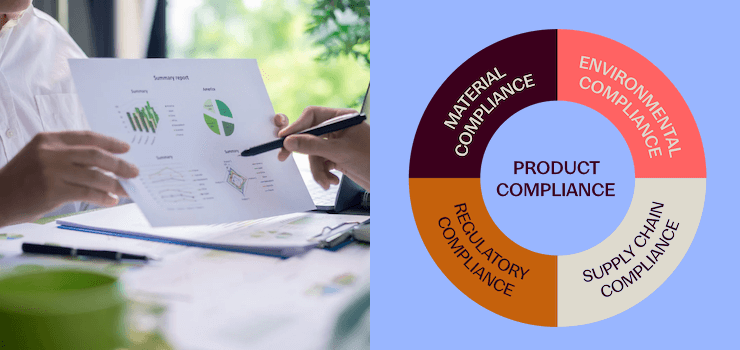The Dodd-Frank Act may have been signed in 2010, but Section 1502 on conflict minerals remains a critical compliance challenge for manufacturers worldwide. While the SEC continues to require annual reporting via Form SD, certain elements of the Conflict Minerals Report have not been actively enforced since 2017. Nevertheless, recent GAO reports confirm persistent gaps in supply chain transparency, and parallel frameworks such as the EU Conflict Minerals Regulation are raising due diligence expectations globally.
This comprehensive guide breaks down what Section 1502 requires, who must comply, and how to transform regulatory obligations into strategic supply chain advantages – including how digital solutions can streamline the entire process.
Table of Contents
- Dodd-Frank Act: Key Facts at a Glance
- Background: What the Dodd-Frank Act Section 1502 Regulates
- Who’s Affected? Applicability and Supply Chain Reach
- Compliance Roadmap: From Inquiry to Filing
- Dodd-Frank Act Challenges: The Data Quality Crisis
- Why Dodd-Frank Act Compliance Pays Off
- The Evolving Landscape: Beyond U.S. Regulation
- How IPOINT Supports Dodd-Frank Act Compliance Digitally
|
Background: What the Dodd-Frank Act Section 1502 Regulates
The Dodd-Frank Wall Street Reform and Consumer Protection Act, named after sponsors Senator Chris Dodd and Representative Barney Frank, became law in July 2010 as a comprehensive response to the 2008 financial crisis. While primarily focused on banking reform and consumer protection, the legislation also addressed a surprising issue: conflict minerals.
Section 1502 of the Dodd-Frank Act requires companies registered with the U.S. Securities and Exchange Commission (SEC) to conduct a Reasonable Country of Origin Inquiry (RCOI) and publicly disclose, through SEC reporting, their use of tin, tantalum, tungsten, and gold – collectively known as 3TG. These minerals must be assessed if they may have originated from the Democratic Republic of Congo (DRC) or any of the nine adjoining countries: Angola, Burundi, the Central African Republic, the Republic of the Congo, Rwanda, South Sudan, Tanzania, Uganda, and Zambia.
Why include supply chain transparency in financial reform legislation? Congress recognized that the mineral trade from this region was directly financing armed conflict and funding militant groups that committed severe human rights violations. By requiring public companies to investigate and report on their mineral sourcing and implement OECD-aligned due diligence measures, Section 1502 aimed to break the economic link between everyday consumer products and violence in Central Africa.
The provision marked a watershed moment: for the first time, U.S. securities law mandated targeted human rights due diligence in global supply chains tied to responsible mineral sourcing.
Navigate Complex Compliance Requirements with Confidence

Turn Section 1502 obligations into a structured, manageable process with purpose-built software that guides you through every step.
Who’s Affected? Applicability and Supply Chain Reach
The Dodd-Frank Act conflict minerals provisions cast a wide net across the United States securities market and beyond. Understanding who must comply - and how far the supply chain obligations extend - is crucial for effective compliance and risk management.
Direct SEC reporting obligations apply to:
- Companies registered with the SEC (both domestic and foreign issuers)
- Businesses that file annual reports with the SEC
- Manufacturers or companies that “contract to manufacture” products containing 3TG minerals
The critical phrase is “necessary to the functionality or production” of a product. If removing the 3TG would impair how a product works or how it is made, Section 1502 applies.
However, the impact extends far beyond SEC registrants. Private companies, small businesses, and international suppliers often face indirect pressure to provide conflict minerals data to their publicly traded customers. This cascade effect means that even non-U.S. companies deep in the supply chain must understand and respond to these reporting and due diligence requirements.
.jpg?width=1024&height=682&name=coltan-mine-in-Rubaya(1).jpg)
Image: Luwowo coltan mine near Rubaya, North Kivu – certified under the CIRGL-RDC system as conflict-free. Coltan, short for columbite–tantalite, is the main source of tantalum used in electronic capacitors.
Compliance Roadmap & Reporting Requirements: From Inquiry to Filing
Meeting Dodd-Frank Act Section 1502 requirements involves a structured three-step process that moves from initial assessment to formal SEC reporting.
Step 1: Reasonable Country of Origin Inquiry (RCOI)
Companies must conduct a good-faith investigation to determine whether their 3TG minerals may have originated from covered countries or came from recycled/scrap sources. This typically includes:
- Surveying direct suppliers using the CMRT template
- Reviewing bills of materials and product data
- Tracking smelter and refiner information through recognized industry programs (e.g., RMI/RMAP)
Step 2: Due Diligence Framework
If the RCOI indicates potential DRC origin, companies must implement due diligence measures aligned with the OECD Due Diligence Guidance:
- Establish strong management systems
- Identify and assess supply chain risks
- Design and implement risk mitigation strategies
- Rely on third-party audit programs (e.g., RMAP) to assess smelter/refiner practices
- Report publicly on due diligence efforts and risk mitigation outcomes
Step 3: SEC Form SD and Conflict Minerals Report
By May 31 each year, affected companies must file Form SD with the SEC. If products contain DRC-origin 3TG (or origin cannot be ruled out), filers may need to include a detailed Conflict Minerals Report describing their due diligence findings.
Note: Since 2017, the SEC has not actively enforced some elements of the Conflict Minerals Report (such as the Independent Private Sector Audit), but accurate and timely Form SD reporting remains mandatory.
Dodd-Frank Act Challenges: The Data Quality Crisis
Even well-intentioned companies face ongoing challenges in conflict minerals compliance. The complexity of global supply chains creates persistent obstacles:
- Multi-tier visibility gaps
Most manufacturers have no direct relationships with smelters or mines. Tracing 3TG minerals through multiple intermediaries — distributors, component manufacturers, and sub-suppliers — often results in incomplete information and dead ends. - Data quality issues
Suppliers may submit incomplete Conflict Minerals Reporting Templates (CMRTs), provide conflicting data about the same materials, or use outdated classifications such as “DRC conflict undeterminable” — a term no longer actively required since 2017 — which offer limited actionable insight for compliance teams. - Resource constraints
Small and mid-sized suppliers often lack the expertise, resources, or systems to perform effective OECD-aligned due diligence, creating weak links in the reporting chain.
Start with Standardized Data Collection
 Download the latest CMRT to ensure suppliers provide complete, consistent information in the industry-standard format.
Download the latest CMRT to ensure suppliers provide complete, consistent information in the industry-standard format.
Why Dodd-Frank Act Compliance Pays Off
Despite these challenges, leading companies are finding that robust conflict minerals programs deliver value far beyond regulatory compliance:
- Risk mitigation
Strong OECD-aligned due diligence processes help identify supply chain vulnerabilities before they escalate into crises — protecting both brand reputation and business continuity. - Competitive advantage
As customers and business partners increasingly demand transparency in supply chain reporting, companies with mature conflict minerals programs are more likely to win contracts, strengthen partnerships, and maintain preferred-supplier status. - ESG leadership
Investors, rating agencies, and financial institutions now consider supply chain transparency a key indicator of overall corporate governance, sustainability performance, and long-term risk management.
The Evolving Landscape: Beyond U.S. Regulation
While the Dodd-Frank Act pioneered mandatory conflict minerals reporting, parallel frameworks are reshaping global expectations:
- EU Conflict Minerals Regulation (since 2021) – Direct obligations for EU importers of 3TG minerals, covering all conflict-affected and high-risk areas (CAHRAs) globally, not just the DRC region.
- UK and Canadian legislation – In the UK, the EU regulation does not apply (except potentially in Northern Ireland); Canada has introduced the Fighting Against Forced Labour and Child Labour in Supply Chains Act (S-211), which requires public supply chain transparency reporting but is broader than conflict minerals.
- Extended minerals scope – Industry initiatives now track cobalt, mica, lithium, and other materials linked to human rights risks. The Extended Minerals Reporting Template (EMRT 2.0), released in 2025 by the RMI, expands reporting beyond 3TG to include critical minerals such as copper, natural graphite, nickel, and others relevant to evolving ESG requirements.
How IPOINT Supports Dodd-Frank Act Compliance Digitally
Managing conflict minerals across global supply chains requires more than spreadsheets and manual tracking. iPoint's integrated solutions automate data collection, validate supplier responses, and generate audit-ready reports – transforming compliance from a burden into a strategic advantage.
Key benefits across all solutions:
- Automated workflows reduce manual effort by up to 80%
- Real-time dashboards provide instant visibility into compliance status
- Standardized templates ensure consistent, accurate reporting
- Seamless integration with existing ERP and PLM systems
Conflict Minerals Reporting Template
Start with the industry-standard Conflict Minerals Reporting Template (CMRT) featuring updated smelter lists and enhanced validation rules.
Responsible Sourcing Platform
Expand beyond 3TG compliance to track cobalt, mica, lithium, and other critical materials. Send multilingual surveys, monitor responses, and build comprehensive ESG programs for responsible sourcing.
Conflict Minerals Software
Centralize your entire compliance process with automated CMRT collection, smelter management, risk analysis, and SEC-ready reporting in one integrated system.
Frequently Asked Questions
How do you comply with Dodd-Frank?
Dodd-Frank Act Section 1502 compliance involves three key steps:
- Conduct a Reasonable Country of Origin Inquiry (RCOI) for all 3TG minerals in your products.
- If sourcing from the DRC or adjoining countries is possible, implement OECD-aligned due diligence measures, including risk assessment, mitigation, and use of recognized industry audit programs (e.g., RMAP).
- Submit an annual Form SD to the SEC by May 31.
Digital tools and standardized templates like the CMRT streamline supplier data collection and reporting.
Is Section 1502 still being enforced?
Yes, but with nuance. The SEC continues to require accurate and timely Form SD filings by May 31. Since 2017, some elements of the Conflict Minerals Report (such as the Independent Private Sector Audit) have not been actively enforced by SEC CorpFin. Recent GAO reports confirm ongoing monitoring, and companies still risk reputational damage, customer delisting, or other consequences for non-compliance.
What happens if my data is “undeterminable”?
You must still file Form SD and describe your due diligence process. The older classification “DRC conflict undeterminable” is no longer specifically required since 2017, but companies often use neutral language such as “origin could not be determined” while outlining continuous improvement measures. Repeated inability to determine origin without progress can raise concerns with the SEC, customers, or investors.
Do non-SEC-listed companies need to comply indirectly?
While non-SEC companies do not file directly with the SEC, many face indirect compliance pressure from publicly traded customers who require conflict minerals data for their own reporting. This cascade effect means private companies, small businesses, and international suppliers often must provide CMRT declarations to maintain business relationships.







.png)
